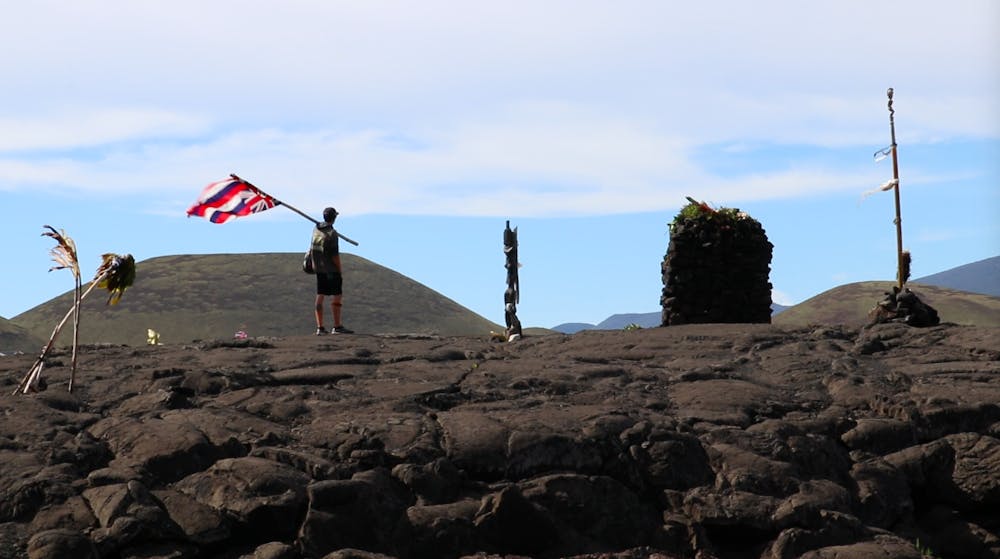Two days after over 30 demonstrators were arrested, freshman Leila Kepaa-Cannella boarded a plane on July 19 from Oahu to the Big Island to protest the thirty-meter-telescope (TMT) being built on the dormant volcano called Mauna Kea.
She was not the only one. It is estimated that by the end of that week, 2,000 people had gathered at the base of the mountain to protest the construction of the TMT, which would be one of the largest telescopes in the world.
For some of UP’s roughly 400 undergraduate students that reside in the state of Hawaii, the conflict at Mauna Kea is complex and polarizing. After nearly 130 days, the protests are still going and, according to a Hawaii News Now article, the cost of government agencies’ responses has surpassed $10 million.

Protestors from near and far perform the hula together.
When Kepaa-Cannella arrived on Mauna Kea, she said she knew it would be an emotional experience.
“When we got up there and I took my first step out of my friend’s truck, I cried. I ended up crying, my friends ended up crying, it’s just so different,” Kepaa-Cannella said. “Seeing a whole community of people just be up there and be as one, it’s a completely different feeling”
According to the TMT’s official website, Mauna Kea is the ideal location for the telescope because the climate and temperature allow for the clearest images of space ever produced. It will also supply jobs and funnel money back into the conservation of Mauna Kea.
Those opposed to the TMT say Mauna Kea is a big part of Hawaiian mythology, because Mauna Kea is seen as the firstborn son of the Earth Mother and Sky Father and is the region of the Gods.
On July 10, Hawaii Gov. David Ige announced that the building of the TMT would start on July 15. The TMT was originally announced in 2009 and was set to begin construction in 2015, however it was in many legal battles until 2018 when the state’s supreme court ruled that the telescope’s second construction permit was valid.
“From the most recent polls, we know the majority of people in the islands support the Thirty Meter Telescope project for the benefits it can provide the state and the world,” Ige said in a Q&A about the TMT on his official website.
A poll conducted by Honolulu Civil Beat found that 64% of registered voters in Hawaii supported the building of the telescope but Native Hawaiians were more likely to be opposed to the building of the telescope. The same poll found that only 21% of those surveyed had a “positive opinion of the governor’s leadership” regarding Mauna Kea.
The Beacon reached out to a UP student who is a resident of Hawaii and is in favor of the TMT being built on Mauna Kea, but the student declined to comment due to the controversial nature of the subject.

Protestors made signs to express their frustration with the Hawaiian government.
Gordon Squires, the TMT vice president of external relations, recently submitted a letter to the editor in the Hawaii Tribune-Herald entitled “TMT: We need a way forward for all,” where he said that the TMT is still committed to their goal of contributing to Hawaii’s future “through astronomy, scientific discovery, economic impact and education.”
“We redesigned the telescope to make sure we wouldn’t have a negative impact environmentally or culturally,” Squires said. “TMT will be located 600 feet below the summit on a site with no archaeological shrines or features, no endangered plants or insects, and no burials. TMT will not prevent traditional and customary Native Hawaiian practices. In fact, it will be accessible to everyone.”
Some residents of Hawaii say the protests on Mauna Kea are about more than just the TMT — the protests are about past issues too.
“They are protesting because there have been historical conflicts and there have been lies to the Hawaiian community,” junior Ka'ulu Ng said. “They aren't mad because they hate science, they don't hate science because part of their culture and the way we found the Hawaiian islands and the way we navigate the globe is through astronomy.”
Junior Elisha Faagai said that she has also noticed a lot of comments on social media criticizing Hawaiians for being anti-science and caring too much about a mountain.
“I’ve seen a lot of comments asking why do Hawaiians care so much about it, it’s just a mountain, how could they be against science over like a mountain,” Faagai said. “I guess people are just criticizing that and saying that Hawaiians are anti-science.”
After law enforcement officers arrested the protestors on July 17 and gave them citations, they were released and many went immediately back to Mauna Kea.

Many Hawaii residents are against the building of the TMT and have been protesting at Mauna Kea since July.
“This is one of the last things we can keep as a people,” Kepaa-Cannella said. “If it means us getting arrested for peacefully standing on the base of a mountain, then that's how it’s going to be because no one is going to give up not ever at this point.”
Because construction on the TMT has been unable to start, the group behind the telescope applied for a permit on the Spanish-controlled Canary Islands. The Canary Islands Astrophysics Institute director welcomed the potential building of the TMT. Despite the alternative option, the Hawaiian government still wants to have the TMT on Mauna Kea.
According to the TMT’s official website, the development of the telescope will provide 300 jobs for the next 8 to 10 years and when the telescope is operational that number will shrink to 140. The TMT wants to hire locally and will initially pay $300,000 rent a year, however, that number will rise to $1 million when the telescope is operational. Eighty percent of the rent money will go into taking care of Mauna Kea and the rest will go to the Office of Hawaiian Affairs.

Protestors chant ‘Ai Ka Mūmū Kēkē, a chant about overcoming adversity, at the base the Mauna Kea access road
Ng thinks building a TMT is a good idea, but that Mauna Kea is not the site to build it on.
“I personally do like the idea of a TMT,” Ng said. “But I feel like it would only be right to build it (on Hawaii) if amends were made between the Hawaiian community and the government because of the historical conflict.”
Junior Nataliya Apa echoed what Ng said. Apa thinks the government should focus on local issues instead of space.
“One of the issues is why are we looking outwards if we aren't even looking out for the people, the natives, that are right in front of us,” Apa said. “What right do we have to look beyond us into space when we should be focusing on the people on earth?”
William Seekamp is a reporter for The Beacon. He can be reached at seekamp22@up.edu.








